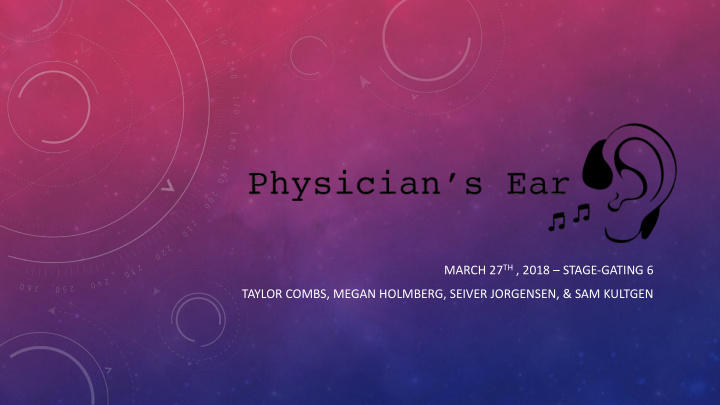



MARCH 27 TH , 2018 – STAGE-GATING 6 TAYLOR COMBS, MEGAN HOLMBERG, SEIVER JORGENSEN, & SAM KULTGEN
Problem Statement Free-field audibly medical alarms are loud and uninformative. The alarms cause sleep deprivation for patients and alarm fatigue for clinicians.
Patient Needs Assessment o Must not infringe on patient confidence in provider o Safety for Patient o Must have informative alarms to improve positive predictive value o Must not interfere with conversation and normal sounds o Must include alert for low battery and system malfunction
Provider Needs Assessment o Provider Efficacy o Interface o Should be available in multiple sizes o Should have volume control o Must be comfortable to wear all day o Should have haptic feedback control o Must stay in ear easily o Should have button to acknowledge receipt of o Transmitted alarms must not overbearing alarm o Should have a haptic component to alarm signal o Safety for Wearer o Must be sterilizable o Must be insulated to prevent shock and excessive o Must have long battery life heating o Should not receive unnecessary alarms to prevent o Must be sweatproof, waterproof alarm fatigue o Must be wireless with stable connection to central hub
System Needs Assessment o Cost Efficacy o Must be able to be purchased in bulk by hospitals or clinics o Should have long shelf life and capability to be activated as needed o Less than $500 per unit o Central Control o Must be able to selectively add patients to individual device o Must be able to direct signal to alert physician and/or nurse by need o Must improve positive predictability of medical alarms.
STUDY
PROTOCOL
PHYSIOLOGICAL SOUNDSCAPES • Comprised of 4 variables • Heart Rate (Drums) • Blood Pressure (Piano) • Blood Oxygenation (Guitar) • Haptic Stimulus Image adapted from Koen Bogers @ TU Delft
SOUND COMPONENTS The physiological soundscapes components change in timbre as the sonified variables move away from the desired set-point range.
+3 PHYSIOLOGICAL +2 +1 STAIRCASE Baseline -1 -2 -3
BUILDING PHYSIOLOGICAL SOUNDSCAPES Built Individual Sound Conditions • Each collects the 4 variables of the • soundscape for a given condition Ex. HR+3, BP-3, SpO2 90, Haptuator -3 • Complied Into Physiological Soundscapes • • This develops changes over time for each 12 minutes block within the study
SSRT AND NEW GRAPHIC USER INTERFACE
NEW GRAPHIC USER INTERFACE Version 2: Solutions Version 1: Issues Added submit button • No submit button • • GUI will not close until clicked • Parameter must be selected before Direction • Radio buttons instead of push buttons Selections not visible • Selection is visible and can be changed • Initial choices cannot be changed • Only one selection possible for each • No allowance for accidental user clicks • category—more foolproof
AfterShokz TREKZ Lofelt Basslet Haptuator Titanium Bone Conductor Headphones
BME IDEAS GRANT
• Description of Problem to be Solved • ICU delirium in up to 80% of patients • Delirium-induced cognitive impairments can last months to years after ICU stay • Final Prototype • Added images to section • Need: further detail about purpose of each component • Estimated Manufacturing Costs • $267 in hardware • ~$300 / device • Regulatory Pathway • Sounds: Class II (510k) • Device: Class I
BIBLIOGRAPHY lirezaee, Parisa, et al. “Did You Feel That? Developing Novel Multimodal Alarms for High Consequence Clinical Environments.” Proceedings of the 23rd International Conference on Auditory Display ICAD 2017 , 2017, doi:10.21785/icad2017.066. Edworthy, J. “Alarms and Human Behaviour: Implications for Medical Alarms.” British Journal of Anaesthesia , vol. 97, no. 1, 2006, pp. 12–17., doi:10.1093/bja/ael114. Edworthy, J. “Fewer but Better Auditory Alarms Will Improve Patient Safety.” Quality and Safety in Health Care , vol. 14, no. 3, Jan. 2005, pp. 212–215., doi:10.1136/qshc.2004.013052. Edworthy, J. “Medical Audible Alarms: a Review.” Journal of the American Medical Informatics Association , vol. 20, no. 3, Jan. 2013, pp. 584–589., doi:10.1136/amiajnl-2012-001061. Edworthy, Judy Reed, et al. “Classifying Alarms: Seeking Durability, Credibility, Consistency, and Simplicity.” Biomedical Instrumentation & Technology , vol. 51, no. s2, 2017, pp. 50–57., doi:10.2345/0899-8205-51.s2.50. Edworthy, Judy, et al. “Improving Auditory Warning Design: Relationship between Warning Sound Parameters and Perceived Urgency.” Human Factors: The Journal of the Human Factors and Ergonomics Society , vol. 33, no. 2, 1991, pp. 205–231., doi:10.1177/001872089103300206 Hasanain, Bassam, et al. “A Formal Approach to Discovering Simultaneous Additive Masking between Auditory Medical Alarms.” Applied Ergonomics , vol. 58, 2017, pp. 500–514., doi:10.1016/j.apergo.2016.07.008. Knox, Richard. “Silencing Many Hospital Alarms Leads To Better Health Care.” NPR, National Public Radio, 27 Jan. 2014, www.npr.org/sections/health-shots/2014/01/24/265702152/silencing- many-hospital-alarms-leads-to-better-health-care. Ruskin, Keith J., and Dirk Hueske-Kraus. "Alarm fatigue: impacts on patient safety." Current Opinion in Anesthesiology 28.6 (2015): 685-690. Schlesinger, Joseph J., et al. “Frequency-Selective Silencing Device for Digital Filtering of Audible Medical Alarm Sounds to Enhance ICU Patient Recovery.” Proceedings of the 23rd International Conference on Auditory Display - ICAD 2017 , 2017, doi:10.21785/icad2017.062. White, Jess. “New for 2016: Joint Commission Updates Alarm Guidelines.” Healthcare News & Insights, Joint Commission, 30 Dec. 2015, www.healthcarebusinesstech.com/alarms-2016/.
Recommend
More recommend